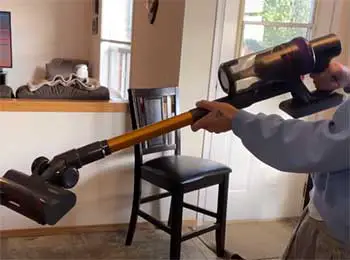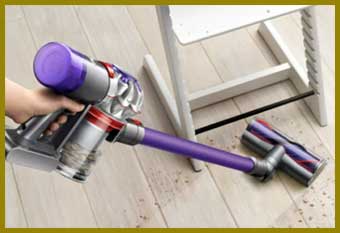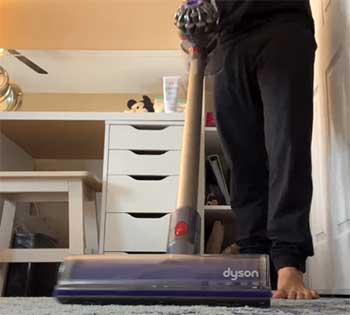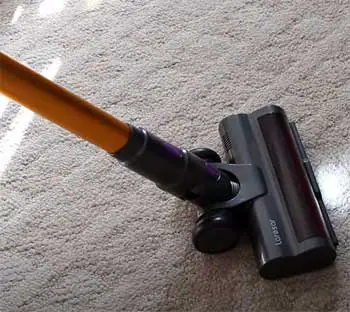When it comes to high-performance vacuum cleaners, two big names always seem to dominate the conversation – Laresar and Dyson. Both brands have become synonymous with powerful suction, innovative technology, and premium design in the floor care space.
But how exactly do these vacuum titans compare? Which one reigns supreme – Laresar or Dyson? To help you decide, here’s an in-depth feature-by-feature face-off.
A Brief Comparison Table
| Feature | Laresar | Dyson |
| Suction Power | 150 AW / 22 kPa | 220 AW / 33 kPa |
| Filtration | 3-stage fully sealed HEPA | Whole-machine HEPA filtration |
| Dust Bin Size | 0.6L – 1.2L | 0.54L |
| Weight | 3.3 lbs – 7.7 lbs | 5.6 lbs – 9.9 lbs |
| Attachments | Crevice tool, brush, soft dusting brush, flexible hose | Combination tool, crevice tool, soft dusting brush |
| Runtime | 40 mins (cordless) | Up to 60 mins (cordless) |
| Warranty | 2 years | 2 years |
Key Differences Between Laresar And Dyson Vacuum Cleaners
- Suction Power and Performance

One of the most important metrics for any vacuum is raw suction power – after all, stronger suction means better cleaning results on floors and carpets.
In this crucial category, Dyson vacuums outperform Laresar across the board.
Top-of-the-line Dyson models like the V15 Detect deliver an ultra-powerful 220 air watts of suction, while most Laresar vacuums max out at around 150 AW.
Real-world cleaning tests confirm Dyson’s superior suction capabilities. Dysons thoroughly deep clean carpets in just one or two passes, while cheaper vacuums struggle to pick up embedded dirt and debris.
However, Laresar vacuums are no slouches either.
With advanced brush rolls, multi-stage filtration, and strategically placed intakes, Laresar vacuums still deliver professional-grade cleaning for most homes. Suction power is lower than Dyson but significantly better than almost any other brand.
For those on a budget, Laresar vacuums strike an excellent balance between cleaning performance and price. But for the absolute best results no matter the cost, Dyson reigns supreme.
- Filtration and Dust Retention

To prevent allergens and microscopic particles from escaping back into the air, high-quality filtration is a must.
Here Dyson pulls far ahead of the competition yet again.
Dyson vacuums feature whole-machine HEPA filters, meaning all the air passing through is filtered to remove 99.97% of particles down to 0.3 microns.
The fully sealed design prevents any unfiltered air from bypassing the system.
Laresar vacuums also utilize multi-stage HEPA filtration. But since the systems aren’t fully airtight, some particles can potentially escape through cracks or crevices.
For dust retention, Laresar vacuums tend to have larger-capacity dust bins around 0.6L to 1.2L, minimizing the hassle of constant emptying. Dyson bins are smaller at just 0.54L, though mostly sealed construction helps reduce dust leaks.
Those sensitive to allergens may want to opt for Dyson to guarantee the cleanest air. But Laresar provides good filtration too, especially for the affordable price tag.
- Design and Ergonomics
With sculptural silhouettes and vibrant color accents, Dyson vacuums are undeniably eye-catching accessories. Signature details like transparent dust bins and exposed cyclone assemblies give Dysons an unmistakable aesthetic.
Laresar vacuums go for function over flash. The utilitarian designs lack Dyson’s flair but prioritize practicality. Thoughtful ergonomic touches like comfy padded handles do help boost usability.
In your hand, most Laresar vacuums feel significantly lighter and easier to maneuver compared to Dyson models. Without bulky motors or overbuilt chassis, Laresar cordless vacuums tip the scales around just 3 to 4 pounds.
Dyson stick vacuums are heavier at 5 to 6 pounds depending on attachments.
If your priority is easy lifting and all-day cleaning convenience, Laresar has the upper hand. But for head-turning style points, Dyson still takes the cake.
- Attachments and Accessories
Having the right attachments can greatly improve a vacuum’s versatility for tackling stairs, upholstery, vehicles, and tricky corners.
Here Dyson pulls ahead by offering a diverse selection of proprietary attachments tailored specifically for their vacuums. From wide nozzle heads to flexible extension hoses, Dyson owners can customize tools based on the needs of each clean.
Laresar vacuums come with a small set of basic attachments like crevice tools, soft dusting brushes, and flexible hoses. But lacking Dyson’s extensive catalog of proprietary addons, capabilities are more limited out of the box.
Dyson’s specialized attachments do come at a premium. Laresar’s included accessories may suffice for most homeowners’ needs at a fraction of the price.
- Cordless Runtime

For cable-free convenience, cordless vacuums rely on rechargeable lithium-ion battery packs.
Longer max runtimes provide more cleaning time before needing a recharge.
Here Laresar falls a bit short, with average motor runtimes around 30 to 45 minutes per charge depending on model.
Budget Laresar cordless vacuums have even shorter runtimes around 15 to 20 minutes.
Flagship Dyson vacuum cleaners outrun the competition, delivering up to 60 minutes of fade-free power per charge. Newer models with larger batteries last even longer between charges.
If you need to vacuum large homes without stopping to recharge, Dyson cordless models offer the best cordless runtimes. Laresar batteries lag behind, but may work fine for smaller spaces.
- Reliability and Durability
With premium price tags, customers expect Dyson and Laresar vacuums to deliver lasting performance. Here reliability reports are mixed.
On average, most Laresar vacuums deliver around 5 to 8 years of useful life. Plasticky construction feels less robust compared to metal-bodied Dysons, but modular designs allow easier repairs.
User reviews praise Dyson’s cutting-edge innovation. But some also report quality control issues and premature breakdowns, especially with newer models. Replacement parts tend to run expensive as well.
Ultimately both brands offer middle-of-the-road reliability. Defective units can slip through with either manufacturer. But in general, expect to get several years of service before major issues arise.
- Pricing and Value
The final consideration for many shoppers comes down to price tags. Dyson vacuums demand ultra-premium prices, often costing $500 to $1000 USD for flagship models. The latest tech innovations levy a hefty surcharge.

Laresar vacuums are priced far more modestly, available for between $150 to $400 USD depending on features.
Lower prices mean compromises in performance but still offer decent cleaning capabilities.
Budget-focused buyers get far better value from Laresar, sacrificing some power for big savings.
For shoppers seeking the absolute best with no compromises, Dyson still reigns supreme – albeit for a luxury cost.
Ultimately choosing between value and performance depends on your priorities and budget. Laresar vacuums pump out tremendous cleaning capabilities for the prices. But Dyson still out-sucks the competition on every metric.
Frequently Asked Questions (FAQ)
Yes, Laresar vacuums offer tremendous value by delivering potent cleaning capabilities without the ultra-premium price tags of more mainstream brands. For budget-conscious shoppers, Laresar vacuums reliably tackle dirt, debris, pet hair, and more at very wallet-friendly prices.
Laresar vacuums are designed in the USA but manufactured overseas in China to keep costs down. Quality control and engineering take place stateside before assembly abroad.
In the premium stick vacuum space, only a few rivals can compete with class-leading Dyson models pound for pound. Top contenders include the LG CordZero A9, Samsung Jet 90, and Miele Triflex. These cordless vacuums rival Dyson’s power at lower prices, but still cost significantly more than value brands like Laresar.
There’s no denying Dyson’s dominance – their cutting-edge vacuums top performance charts in nearly every category. No other brand matches Dyson’s game-changing engineering and real-world cleaning results. So if money is no object, Dyson vacuums decisively rank as the best you can buy today. Just prepare to pay a hefty premium for the luxury of Dyson ownership!
Closing Remarks
When comparing Laresar and Dyson vacuums side-by-side, Dyson consistently comes out ahead on metrics like suction power, filtration, attachments, and runtime.
But outstanding performance comes at an incredible cost – most Dyson vacuums demand ultra-premium prices around $500 to $1000 USD.
That puts Laresar vacuums in prime position if you want great cleaning without draining your savings. For a fraction of a Dyson’s price, Laresar vacuums still pack potent suction and thoughtful features optimized for real-world usage.
Here’s a quick recap on choosing between Laresar and Dyson:
- Dyson: Ultimate cleaning performance – but very expensive
- Laresar: 90% of Dyson’s power at 50% of the price or less
We recommend Laresar for value seekers wanting reliable deep cleaning on a budget. But for shoppers who desire best-in-class capabilities regardless of cost, Dyson still rules the roost.
Either brand you choose, rest assured your floors are in good hands!
